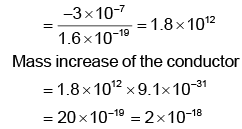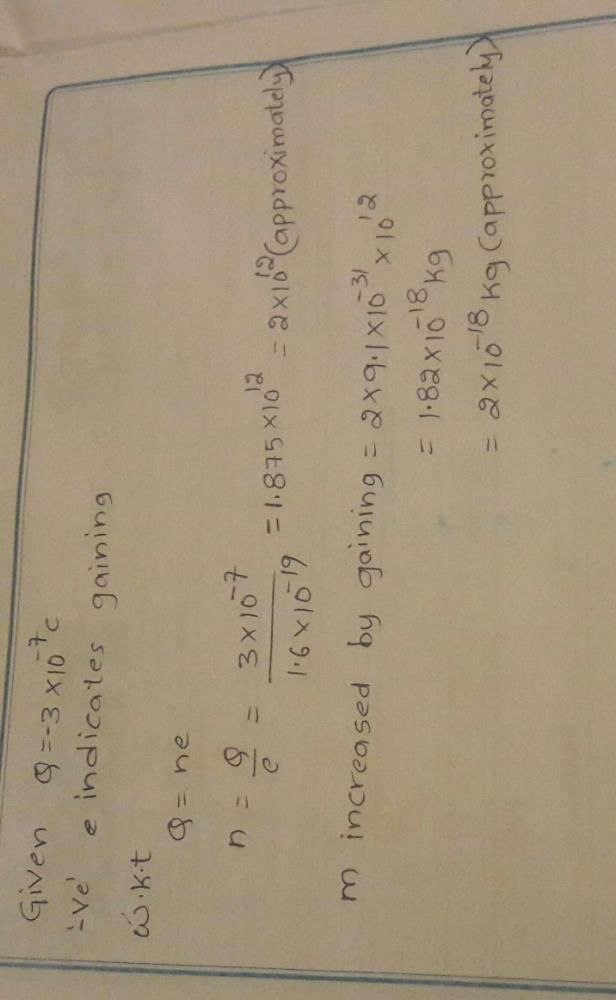Class 12 Exam > Class 12 Questions > A conductor has been given a charge -3×...
Start Learning for Free
A conductor has been given a charge -3×10-7C by transferring electrons. Mass increase (in kg) of the conductor and the number of electrons added to the conductor are respectively.
- a)2 ×10-16 and 2 ×1031
- b)5 ×10-31 and 5 ×1019
- c)3 ×10-19 and 9 ×1016
- d)2 ×10-18 and 2 ×1012
Correct answer is option 'D'. Can you explain this answer?
Verified Answer
A conductor has been given a charge -3×10-7C by transferring ele...
Number of electrons added to the conductor
n = q/e

n = q/e
Most Upvoted Answer
A conductor has been given a charge -3×10-7C by transferring ele...

Free Test
FREE
| Start Free Test |
Community Answer
A conductor has been given a charge -3×10-7C by transferring ele...
Mass Increase and Number of Electrons Added Calculation:
The charge given to the conductor is -3×10^-7 C. This charge is due to the transfer of electrons to the conductor.
Mass Increase Calculation:
Given that the charge on the conductor is -3×10^-7 C.
We know that mass increase (Δm) can be calculated using the formula:
Δm = ΔE / c^2
where ΔE is the change in energy, and c is the speed of light.
Since the charge is due to the transfer of electrons, we can calculate the energy associated with the charge using the formula:
ΔE = qV
where q is the charge and V is the potential difference.
Assuming a potential difference of 1V, we can calculate the energy associated with the charge:
ΔE = -3×10^-7 C × 1V = -3×10^-7 J
Now, we can calculate the mass increase:
Δm = (-3×10^-7 J) / (3×10^8 m/s)^2
Δm = -3.33×10^-24 kg
Therefore, the mass increase of the conductor is 2×10^-24 kg.
Number of Electrons Added Calculation:
The number of electrons added can be calculated using the formula:
q = Ne
where q is the charge, e is the charge of an electron (1.6×10^-19 C), and N is the number of electrons.
Given that the charge is -3×10^-7 C, we can calculate the number of electrons added:
-3×10^-7 = N × 1.6×10^-19
N = -3×10^-7 / 1.6×10^-19
N = -1.875×10^12
Therefore, the number of electrons added to the conductor is 2×10^12.
Therefore, the correct answer is option 'D' - 2×10^-24 kg and 2×10^12 electrons.

|
Explore Courses for Class 12 exam
|

|
Similar Class 12 Doubts
A conductor has been given a charge -3×10-7C by transferring electrons. Mass increase (in kg) of the conductor and the number of electrons added to the conductor are respectively.a)2 ×10-16 and 2 ×1031b)5 ×10-31 and 5 ×1019c)3 ×10-19 and 9 ×1016d)2 ×10-18 and 2 ×1012Correct answer is option 'D'. Can you explain this answer?
Question Description
A conductor has been given a charge -3×10-7C by transferring electrons. Mass increase (in kg) of the conductor and the number of electrons added to the conductor are respectively.a)2 ×10-16 and 2 ×1031b)5 ×10-31 and 5 ×1019c)3 ×10-19 and 9 ×1016d)2 ×10-18 and 2 ×1012Correct answer is option 'D'. Can you explain this answer? for Class 12 2025 is part of Class 12 preparation. The Question and answers have been prepared according to the Class 12 exam syllabus. Information about A conductor has been given a charge -3×10-7C by transferring electrons. Mass increase (in kg) of the conductor and the number of electrons added to the conductor are respectively.a)2 ×10-16 and 2 ×1031b)5 ×10-31 and 5 ×1019c)3 ×10-19 and 9 ×1016d)2 ×10-18 and 2 ×1012Correct answer is option 'D'. Can you explain this answer? covers all topics & solutions for Class 12 2025 Exam. Find important definitions, questions, meanings, examples, exercises and tests below for A conductor has been given a charge -3×10-7C by transferring electrons. Mass increase (in kg) of the conductor and the number of electrons added to the conductor are respectively.a)2 ×10-16 and 2 ×1031b)5 ×10-31 and 5 ×1019c)3 ×10-19 and 9 ×1016d)2 ×10-18 and 2 ×1012Correct answer is option 'D'. Can you explain this answer?.
A conductor has been given a charge -3×10-7C by transferring electrons. Mass increase (in kg) of the conductor and the number of electrons added to the conductor are respectively.a)2 ×10-16 and 2 ×1031b)5 ×10-31 and 5 ×1019c)3 ×10-19 and 9 ×1016d)2 ×10-18 and 2 ×1012Correct answer is option 'D'. Can you explain this answer? for Class 12 2025 is part of Class 12 preparation. The Question and answers have been prepared according to the Class 12 exam syllabus. Information about A conductor has been given a charge -3×10-7C by transferring electrons. Mass increase (in kg) of the conductor and the number of electrons added to the conductor are respectively.a)2 ×10-16 and 2 ×1031b)5 ×10-31 and 5 ×1019c)3 ×10-19 and 9 ×1016d)2 ×10-18 and 2 ×1012Correct answer is option 'D'. Can you explain this answer? covers all topics & solutions for Class 12 2025 Exam. Find important definitions, questions, meanings, examples, exercises and tests below for A conductor has been given a charge -3×10-7C by transferring electrons. Mass increase (in kg) of the conductor and the number of electrons added to the conductor are respectively.a)2 ×10-16 and 2 ×1031b)5 ×10-31 and 5 ×1019c)3 ×10-19 and 9 ×1016d)2 ×10-18 and 2 ×1012Correct answer is option 'D'. Can you explain this answer?.
Solutions for A conductor has been given a charge -3×10-7C by transferring electrons. Mass increase (in kg) of the conductor and the number of electrons added to the conductor are respectively.a)2 ×10-16 and 2 ×1031b)5 ×10-31 and 5 ×1019c)3 ×10-19 and 9 ×1016d)2 ×10-18 and 2 ×1012Correct answer is option 'D'. Can you explain this answer? in English & in Hindi are available as part of our courses for Class 12.
Download more important topics, notes, lectures and mock test series for Class 12 Exam by signing up for free.
Here you can find the meaning of A conductor has been given a charge -3×10-7C by transferring electrons. Mass increase (in kg) of the conductor and the number of electrons added to the conductor are respectively.a)2 ×10-16 and 2 ×1031b)5 ×10-31 and 5 ×1019c)3 ×10-19 and 9 ×1016d)2 ×10-18 and 2 ×1012Correct answer is option 'D'. Can you explain this answer? defined & explained in the simplest way possible. Besides giving the explanation of
A conductor has been given a charge -3×10-7C by transferring electrons. Mass increase (in kg) of the conductor and the number of electrons added to the conductor are respectively.a)2 ×10-16 and 2 ×1031b)5 ×10-31 and 5 ×1019c)3 ×10-19 and 9 ×1016d)2 ×10-18 and 2 ×1012Correct answer is option 'D'. Can you explain this answer?, a detailed solution for A conductor has been given a charge -3×10-7C by transferring electrons. Mass increase (in kg) of the conductor and the number of electrons added to the conductor are respectively.a)2 ×10-16 and 2 ×1031b)5 ×10-31 and 5 ×1019c)3 ×10-19 and 9 ×1016d)2 ×10-18 and 2 ×1012Correct answer is option 'D'. Can you explain this answer? has been provided alongside types of A conductor has been given a charge -3×10-7C by transferring electrons. Mass increase (in kg) of the conductor and the number of electrons added to the conductor are respectively.a)2 ×10-16 and 2 ×1031b)5 ×10-31 and 5 ×1019c)3 ×10-19 and 9 ×1016d)2 ×10-18 and 2 ×1012Correct answer is option 'D'. Can you explain this answer? theory, EduRev gives you an
ample number of questions to practice A conductor has been given a charge -3×10-7C by transferring electrons. Mass increase (in kg) of the conductor and the number of electrons added to the conductor are respectively.a)2 ×10-16 and 2 ×1031b)5 ×10-31 and 5 ×1019c)3 ×10-19 and 9 ×1016d)2 ×10-18 and 2 ×1012Correct answer is option 'D'. Can you explain this answer? tests, examples and also practice Class 12 tests.

|
Explore Courses for Class 12 exam
|

|
Signup for Free!
Signup to see your scores go up within 7 days! Learn & Practice with 1000+ FREE Notes, Videos & Tests.



















